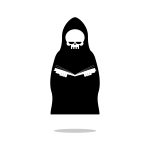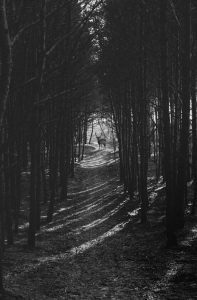For all of those who struggle with identity, the lack of symmetry implies a personal failing. In my case, all my life has been a struggle of ‘you are not enough x, y, z.’ I often struggled to define myself with what I could mimic in order to pass. Just enough to blend-in. Or try, because there were parts of me that would give me away: my accent, the shade of my hair, my ignorance over cultural nuances, my sudden relapse into feeling romance. All of these felt like a betrayal of what should be a clear line.
To me, identity and horror are inextricably linked; whether our struggle with identity colours our writing or we look for ourselves when reading other’s works to connect, horror gifts us with a realm of exploration and possibilities in which trauma may be recontextualized. And within that comes the realisation that identities are not clear-cut. They are permeable, they overlap, they shift with time and become a guide and lens with which we view ourselves.
Intersectionality comes with its own challenges as we repress or highlight parts of ourselves depending on our surroundings. It usually isn’t significant things, they’re tiny details but make one mistake too many and people are sure to pick up on it. For example, I make sure to use my chopsticks properly when eating with Asian friends, but I hide how well I know how to use them during meals with non-Asian friends. We become octopi, trying to blend into environments seamlessly, then as we are fished out we shift once more: we want to belong, we want to feel safe, we want to find common ground with our friends and colleagues and family.
For the longest of times I thought my identity had to be divisible: a perfect line bisecting me in half to delineate where one part of my identity ended and the other began. Both parts equal, differentiated only by separate shades. This was a subconscious thought, an assumption of how things were supposed to be. Something that I, and I am sure many others, think about at least in passing. Balance, as a concept, is present everywhere. It is meant to be attractive, to draw you in.
So what rises to the forefront of the mind when you realise parts of you are not equally divided as they should be? No 50% asexual, 50% allosexual. No 50% Latinx, 50% Asian. Unlike with mitosis, which splits our personal nuances into neat packages distributed into equal parts. Each of us is a unique print in this world.There has never been a neat split, and it may be our reaction to seek out a way to force there to be when you realise there is none. Thoughts of inadequacy may become an ongoing plague.
There are no clear lines, and the beauty of those nuances should be embraced, in ourselves but also in our writing. A daunting prospect, if writing is an act of vulnerability and putting parts of yourself you keep hiding from particular people out there feels, for a lack of better word, complicated. I struggle with the question all the time: is this enough? Not just in terms of identity but in my choice of genre, horror.
A lot of horror writers are always asking the question, what is horror? All with a variety of valid answers and interpretations. Horror often asks the question of identity, of otherness and its place. A common misused trope is the ‘other’ as the monster, with implications that cannot be overlooked, but in recent years that ‘otherness’ in horror has given marginalised identities a home for expression, exploration and discovery. It certainly was what appealed to me about horror.
The secrecy, the layers, the discovery of the horror appeals to me. Just like the team in Annihilation slowly peeling back the mystery of Area X only to be met with more questions and non-answers, my intersectional identity feels like an ongoing investigation. Should I be afraid of what I may find? Yes, perhaps. There is anxiety, fear of rejection, confusion–but ultimately, I continue to unravel pieces of myself the more I explore writing.
The wrongness, the minor asymmetry that makes that primal instinct go on guard is one of the ways in which tension can be achieved. But symmetry can be used to create horror too. The example that always comes to mind here is Kubrick’s The Shining, in which the Overlook’s perfect symmetry is a breeding ground for anxiety and tension; and in King’s book, it is the Overlook’s perfectly manicured topiary that gave me nightmares for weeks. I love perfection as a device to build tension; give me those clean, shiny surfaces that reflect everything so clearly under the light of the sun, construct something so immaculate that it haunts me for weeks.
With identity, symmetry can be just as disturbing. Is this perfect split not as eerie as the Overlook’s haunted hallways? Why then do we struggle to put ourselves into perfectly labelled boxes? Why do we focus on bisecting ourselves to make sure we are just the right amount of x, y or z?
Just like horror can utilise symmetry and asymmetry, identity has breathing room, malleability that makes each individual unique. There is no such thing as ‘not enough’.
Tania Chen is a Chinese-Mexican queer writer. Their work was selected for Brave New Weird Anthology by Tenebrous Press, and has also appeared in Unfettered Hexes by Neon Hemlock, Apparition Lit, Strange Horizons, Pleiades Magazine, Baffling Magazine, The Dread Machine and Longleaf Review, among others. They are a graduate of the Clarion West Novella Bootcamp workshop of January/Feb 2021 and assistant editor for Uncanny Magazine.
Photo by Stefano Pollio on Unsplash






